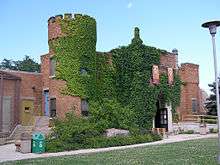Racine Zoo
 (photo July 2010) | |
| Date opened | 1923[1] |
|---|---|
| Location | Racine, Wisconsin, United States |
| Coordinates | 42°44′56″N 87°47′01″W / 42.7488°N 87.7837°WCoordinates: 42°44′56″N 87°47′01″W / 42.7488°N 87.7837°W |
| Land area | 32 acres (13 ha)[1] |
| Memberships | AZA[2] |
| Website |
racinezoo |
The Racine Zoological Gardens, or Racine Zoo, is a zoo situated on 32 acres (13 ha) on the shore of Lake Michigan in Racine, Wisconsin. The zoo is operated by the Racine Zoological Society, a non-profit organization. With more than 100 species of animals,[3] the zoo's collection focuses on species native to Wisconsin, including a room dedicated to reptiles and amphibians indigenous to the state.
History
The Racine Zoo was founded in March 1923, by local businessman Jacob Stoffel, Jr. His donation of three monkeys spurred the city of Racine to build a small zoo in Island Park. Within that year, the zoo featured deer, badgers, gray foxes, and Rocky Mountain goats. After it outgrew the space, the zoo's current location at Goold Street and North Main Street, opened in 1925. The site had previously been part of Lakeview Park, which was a former brickyard.
The Racine Zoo quickly grew in its new location. Between 1925 and 1929, it added exhibits featuring sea lions, hoofed animals, and bears. A duck pond was created by flooding an abandoned clay quarry. During the Great Depression, the zoo's free admission allowed it to thrive while others were forced to close. The castle-like Vanishing Kingdom, which houses big cats and primates, was completed in 1939. It was built using bricks from the former county jail.
On May 23, 1958, Mary Heibner, a ten-year-old girl from Waukegan, Illinois, was mauled by a bear at the zoo. She nearly lost her right arm and required plastic surgery.
In November 1959, due to overcrowding, the Como Park Zoo relocated a two-year-old Siberian tiger to Racine. The Racine Zoo purchased the tiger, named Kahn, the following year.
On May 13, 1985, 35 ducks, geese and swans living in the zoo´s duck pond were put down after the zoo was hit by a plague of duck viral enteritis.
In November of that year, the zoo became the host of the Kiwanis-Wheary Lights, an annual holiday light display. The lights were the creation of George H. and Jessie May Wheary, who held the display at their home in North Bay from 1962 to 1982. The lights were shown in Monument Square until Kiwanis became the owner of the lights.
The Australian division of S.C. Johnson & Son, whose headquarters are in Racine, gifted six kangaroos and six wallaroos to the zoo in 1987. Australian ambassador Rawdon Dalrymple attended the ceremony.
In May 1996, the zoo acquired Moon Shadow, a seven-year-old Asian snow leopard. The leopard died in December.
The zoo operated as a free-admission attraction until January 1, 2007, when fiscal needs required the introduction of an admission fee.
On February 10, 2011, Julie, the oldest patas monkey in recorded history, died at the Racine Zoo, where she had been born and spent almost all of her life. She was euthanized at the age of 28.
Animals
The Racine Zoo features animals from all over the world. Despite the zoo's small area, its collection continues to grow.
Mammals
- Red kangaroo
- Common wallaroo
- Straw-coloured fruit bat*
- Blue-eyed black lemur
- Geoffroy's spider monkey
- Lar gibbon
- Orangutan
- Tufted deer
- Hoffmann's two-toed sloth
- Llama
- Spectacled bear
- Dromedary camel
- South American coati
- Striped skunk*
- Suri alpaca
- Slender-tailed meerkat
- Transvaal lion
- Siberian tiger
- Canada lynx
- Fennec fox
- Eastern black rhinoceros
- Masai giraffe
- West Caucasian tur
- Fossa
Amphibians
Fish
Birds
Reptiles
(*) Denotes education program animals not normally on exhibit
The zoo's grounds are also home to a playground, a children's zoo, and a hands-on discovery center; free Sunday band concerts and the Animal Crackers Jazz Series are held during the summer.
References
- 1 2 Racine Zoo Facts
- ↑ "List of Accredited Zoos and Aquariums". aza.org. AZA. Retrieved April 27, 2012.
- ↑ https://www.racinezoo.org/history
External links
 Media related to Racine Zoo at Wikimedia Commons
Media related to Racine Zoo at Wikimedia Commons- Official website